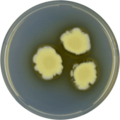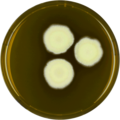| Aspergillus navahoensis | |
|---|---|
| Scientific classification | |
| Kingdom: | Fungi |
| Division: | Ascomycota |
| Class: | Eurotiomycetes |
| Order: | Eurotiales |
| Family: | Aspergillaceae |
| Genus: | Aspergillus |
| Species: | A. navahoensis |
| Binomial name | |
| Aspergillus navahoensis M. Christensen & States (1982) [1] | |
Aspergillus navahoensis is a species of fungus in the genus Aspergillus . It is from the Nidulantes section. [2] The species was first described in 1982. [1] It was isolated from sand in Arizona, United States. [2] It has been reported to produce averufin, norsolorinic acid, 6,7,8-trihydroxy-3-methylisocoumarin, [3] desferritriacetylfusigen, echinocandin B, [4] and sterigmatocystin. [5]

